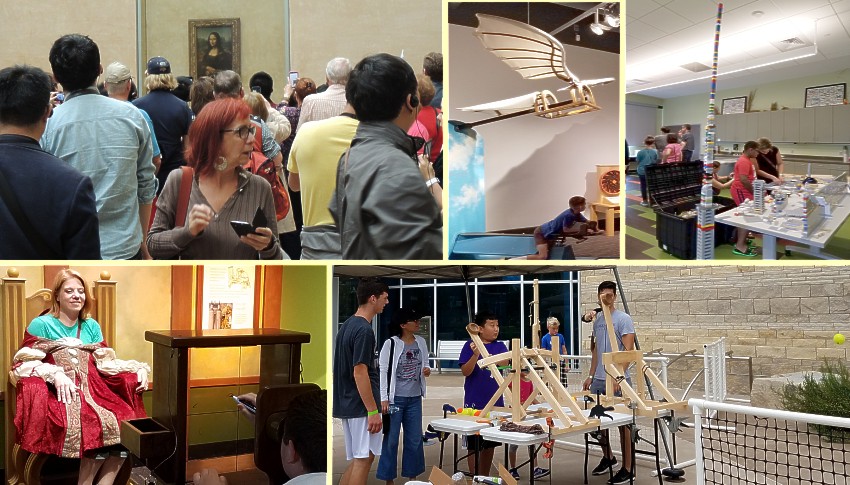Kansas Snapshots by Gloria Freeland - September 6, 2019
Da Vinci still inspires
Leonardo da Vinci died 500 years ago, but still inspires people today. This year, museums and art galleries around the world are
commemorating his life with special exhibits designed to stimulate interest in the Italian artist, engineer, mathematician, inventor
and philosopher.
In late May and again a couple of weeks ago, I visited the "Dream with Da Vinci" exhibit at the Flint Hills Discovery Center in
Manhattan, Kansas. It was hands-on and helped participants learn about many of da Vinci's inventions and the importance of the
Renaissance - the period from roughly the 14th to the 17th centuries when Europe experienced a cultural, artistic, political and
economic "rebirth" after awakening from the Middle Ages.
During my recent visit to the center's "Da Vinci Day," I watched youngsters and adults launch tennis balls and other objects
with catapults, make clay creations, draw and paint, build towers and other objects with LEGOs, construct boats, steer a glider,
and test parachutes. Some spent a lot of time focusing on one activity, while others rushed from station to station.
That rushing made me smile as I remembered when husband Art and I took our daughters Mariya, then 17, and Katie, then 10, to the
Louvre Museum in Paris. Both were familiar with da Vinci's Mona Lisa painting and were eager to see her up close and personal. Katie
said she was somewhat disappointed when they finally caught a glimpse of her.
... It was a long wait to see her and she was SO MUCH SMALLER than I was expecting ... I'd say that there are so many other magnificent
pieces of art in the Louvre from that same period (and from da Vinci himself) that it's a shame that so many (like myself) rush through
the rest of the art exhibits just to see her.
Perhaps da Vinci had unwittingly taught our girls a lesson as true today as in his time. He didn't seem to rush through his inventions
and artistic creations either.
The Mona Lisa, at only 30 inches high by 21 inches wide, seems quite small in comparison with many other works of art. Researchers
still aren't sure whether da Vinci actually considered it finished. He continued to work on it during the last three years of his life.
I use da Vinci to inspire students in my journalism classes at Kansas State University and try to emulate his philosophy, described
in my column "Learning how to see."
In a May/June 2018 Saturday Evening Post article, "Learning from Leonardo," Walter Isaacson, Tulane University history
professor, captured da Vinci's humanity as well as his genius.
The fact that Leonardo was not only a genius but also very human - quirky and obsessive and playful and easily distracted - makes him
more accessible. He was not graced with the type of brilliance that is completely unfathomable to us. Instead, he was self-taught and
willed his way to his genius. So even though we may never be able to match his talents, we can learn from him and try to be more like
him. His life offers a wealth of lessons.
Among those lessons, Isaacson said, are to be curious, to retain a childlike sense of wonder, to observe, to get distracted, to think
visually, to indulge in fantasy, to take notes on paper, to be open to mystery and to wander across the disciplines of the arts,
sciences and humanities.
In a later interview in Quartz magazine, Isaacson said:
There is a criticism of Leonardo. If he had not squandered so much of his time, he could have finished more painting. But had he done
that, he would not have been Leonardo da Vinci. ... He is the patron saint of distracted kids. We sometimes worry about our kids
getting too distracted or daydreaming. That's what Leonardo da Vinci did.
Isaacson isn't suggesting wandering aimlessly. He noted that da Vinci was disciplined and made lists of the questions he wanted to
explore each week.
He also mentioned that Apple founder Steve Jobs "ended every meeting with a street sign showing the intersection of the liberal arts and technology ... that's
where creativity occurs," adding, "Even Einstein, when he got stumped by the law of relativity, would pull out his violin."
The discovery center's Curator of Education Stephen Bridenstine said 462 people attended "Da Vinci Day." K-State's College of
Architecture, Planning and Design staffed most of the activities, with help from the Marianna Kistler Beach Museum of Art and
volunteers from the Smith Scholarship House.
Joel Guess, a Smith house volunteer, helped staff the catapult station.
Some of the parents seemed very keen to ask their kids why they thought things happened the way they did, and used it as a good
learning opportunity, which I thought was cool ... Just seeing the kids' faces light up when they got to catapult the tennis balls
was really fun. I remember one kid who was really interested in seeing what would happen if you tried different modifications with
the catapult. So we tried firing multiple tennis balls at once, and we also tried stopping the firing arm short to see how it would
change the trajectory of the ball.
Questioning and experimentation were an integral part of da Vinci's life, for he wasn't afraid to try new things. So while five
centuries have passed since his death, people such as Einstein, Jobs and the vistors at the discovery center show da Vinci's approach
to life is as applicable today as it was in his lifetime.
